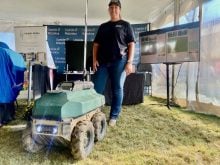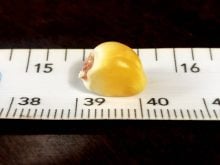The annual Ontario Grain Corn Ear Mould and Deoxynivalenol (DON) Mycotoxin Survey found that 98 per cent of samples tested low, at less than two parts per million, for DON.
Also known as vomitoxin, DON is produced primarily by gibberella/fusarium ear moulds and can be disruptive when fed to livestock, especially hogs. Corn ear moulds such as gibberella and their corresponding mycotoxins occur every year in Ontario.
Why it matters: The survey provides a baseline for moulds and mycotoxins present in Ontario corn, which can affect feeding quality for livestock.
Read Also

The forced Japanese-Canadian farmers of the Second World War
Manitoba’s sugar beet farms drew on displaced Japanese-Canadians from B.C. during the Second World War
The survey is annually conducted by OMAFRA field crop specialists in collaboration with Grain Farmers of Ontario and members of the Ontario Agri-Business Association.
Surveyors collected 193 corn ear samples from across the province Sept. 28 to Oct. 5.

Five consecutive ears were collected from four random locations throughout a field and placed into high temperature driers (80 C) as soon as possible after collection.
Photos were taken to document moulds and insect/bird feeding damage. Dry ears were shelled, coarse ground and mixed for sub-sampling consistency. Sub-samples were collected and finely ground for DON analysis at the University of Guelph Ridgetown Campus mycotoxin lab.
Although ear moulds were evident in some samples, analysis showed that severity was low. Many ears displayed no symptoms and only one sample tested five ppm or greater.
As in recent years, insect feeding appeared low, but where present was often associated with visual ear mould. Other mouldy samples with no ear damage were observed where weather and hybrid susceptibility were likely factors.
“While 98 per cent of 2022 samples tested below two ppm, growers should still remain vigilant and understand management options in fields with higher DON concentrations,” surveyor authors said in a release. “Ear moulds and mycotoxins occur every year in Ontario and fields need to be assessed individually.”

[RELATED] U.S. corn farmers wary of vomitoxin, latest stress on global grain supplies
Advantageous growing season
Corn planting was slightly delayed as lingering rains and cooler weather limited soil drying through early May for much of the province. Once conditions were fit, planting progressed rapidly, occurring in the second to third week of May for many areas.
Weather generally remained sunny and dry through planting. Except for some scattered showers and local pockets that received heavier rains, the southwest remained predominantly dry through June and July. Widespread rain events were more common in central and eastern Ontario.
Dry conditions and moisture stress in very dry areas generally dominated through most of tasseling. This likely delayed ear mould inoculum production and limited establishment during the early fresh silk window.
By early August, widespread rain events covering much of the province became more common and remained relatively steady for many areas through September. Where ear moulds had established, these conditions were likely favourable for continued growth and development.
[RELATED] Accidental discovery could be a mycotoxin game-changer
Feeding damage
Ear feeding by pests, particularly western bean cutworm (WBC), corn earworm or birds can open husks, damage kernels and present opportunities for greater ear mould infection and DON. Feeding damage appeared very low in 2022 survey samples. Peak WBC moth flights generally occurred in late July to early August, slightly after tasseling. Where feeding damage was present, visual mould symptoms were often more apparent.
Surveyors note the survey does not capture all regions of the province and results can vary from field to field depending on local weather, hybrid, planting date, insect feeding, rotation, residue levels, fungicide practices and moisture.
“Results may not capture what is occurring in your field, therefore monitoring is always recommended,” they said.
2023 considerations
Preventing ear rots and mould can be difficult since weather is critical to development, but hybrid selection is important. Although tolerant hybrids are available, none have complete resistance and surveyors encourage growers to discuss ear mould tolerance with their seed supplier.
The Ontario Corn Committee has initiated inoculated DON trials for evaluating differences in DON susceptibility across Ontario hybrids. After the environmental issues experienced in 2019, surveyors said protocols have been refined over the past couple growing seasons.
[RELATED] How to get more accurate DON toxin readings
Crop rotation may help reduce ear rots, while certain foliar fungicides are also registered for suppressing ear rots but need to be applied at VT/R1 when silks are green. Cultural practices such as tillage are shown to have limited success in preventing ear and kernel rots.
– This is adapted from an OMAFRA Field Crop News report authored by OMAFRA corn specialist Ben Rosser and field crop pathologist Albert Tenuta.














